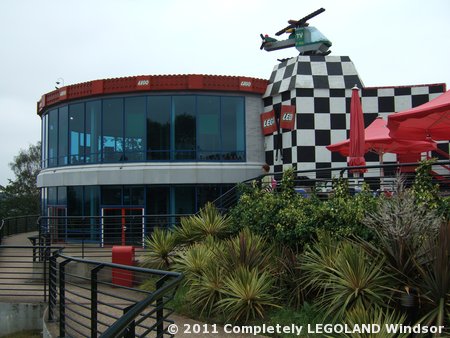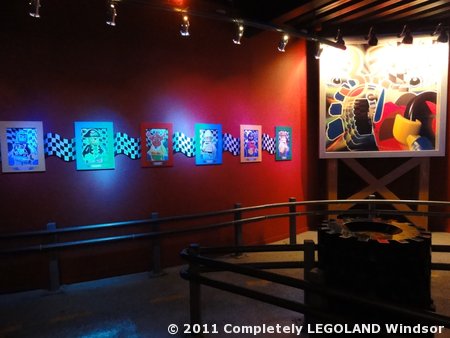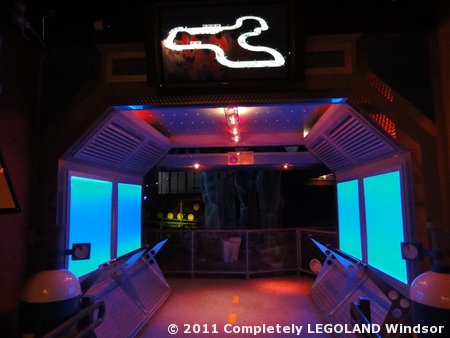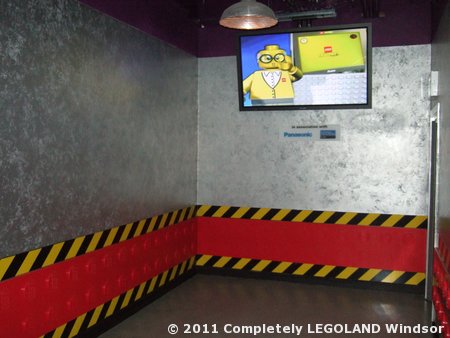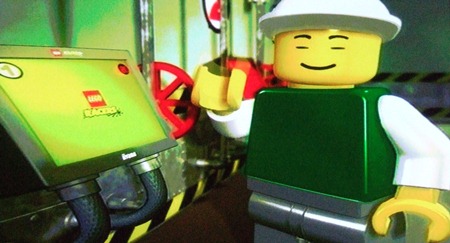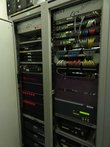Rocket Racers (Retired)

Rocket Racers, a ground-breaking attraction for its time, and an attraction with perhaps the most interesting history of all rides at LEGOLAND Windsor, closed its shutter for the final time on Sunday 9th October 2011.
Fans of the park will remember the last time this occurred, at the end of the 2004 season – it was missed by many, many people, not least by those who created it, but come 2009 and the park had a surprise: Rocket Racers still existed, and was to return! It enjoyed an additional (and somewhat unexpected) three more seasons, entertaining many, many guests, but unfortunately towards the end of 2011 it closed once again, and this time permanently.
Completely LEGOLAND Windsor takes a moment to reflect on Rocket Racers’ remarkable history.
LEGO Racers LBE - Conception and First Opening:
Back before the year 2000, at a time when LEGOLAND Windsor was owned fully by the LEGO Group, an attraction was needed to fill a large area of what was to be the Creation Centre.
By the very nature of the centre, and indeed the park, it had to promote creativity, imagination, and (of course) fun! The job of creating this attraction fell to a number of people: Rob Baker and ATD (Attention To Detail), the now sadly defunct gaming company behind LEGO Racers 2 and Drome Racers, (both LEGO computer games), as well as Rollcage (a racing game for the PC and PlayStation One); Nick Bodenham, James Dobbs, Andy Donnely, Des Gayle and Karl Fentimen from LEGO Media (James is now the current Entertainment and Innovations Manager at LEGOLAND Windsor); and Graham Owens from Technovations (a technical design company behind many theme park installations). Between them, they took the existing game engine from Rollcage, and set about transforming it into an immersive, interactive, multi-player LEGO attraction, that incorporated the values mentioned above.
To this end, ‘LEGO Racers LBE’ was born, and opened during the Christmas 2000 season. (This was the attraction’s full original name, where LBE stands for Location Based Entertainment – to guests, it was simply LEGO Racers).
LEGO Racers originally consisted of five ‘lanes’: three downstairs, and two upstairs. To get to these lanes, guests queued through what is arguably the most richly themed queueline in LEGOLAND Windsor to date.
Each lane, capable of taking eight guests, was split in to three rooms. First, the eight guests enter a briefing room, where an instructional (and highly entertaining!) video, narrated by Dave Lamb, was shown.
This video followed Larry, a loveable minifig, as he himself went through the building and racing process, making humorous mistakes along the way.
Following this, the next door would open automatically, and guests would make their way into the building room. Here the creativity really flowed, as guests created their own minifig driver and car, and then entered their name (into a system which of course had a comprehensive profanity filter, which lead to certain small issues such as Richards not being able to use their shortened name!).
Guests were next shown a brief instructional video reminding them how to race, before the next automatic door opened, and the group moved on to the race itself.
Here, each guest found their race pod (having remembered their colour and number from the building room), and sat down, ready for a three minute race in their freshly-created cars and drivers against the others in their group. Come the end of the race, and their position would be displayed on their screen for all to see! There had been plans for a screen at the exit to all lanes to display results from the whole day, but as with many things in projects like this at any visitor attraction, that sadly did not come to fruition.
That, in a nutshell, was LEGO Racers. It was very popular, especially amongst those who visited the park regularly, and despite its well-hidden location, it always had a queue.
From a technological point of view, it was stunning: each lane had a host computer, acting as a ‘supervisor’ and information handler for sixteen further computers – eight build machines, and eight racing machines. Each entire floor was then controlled by a specialist piece of equipment called a ‘Conductor Avenger Show Control’: this was a fantastic piece of kit which controlled everything, from the lighting and sound, to the automatic doors and videos, even through to the supply for the standard 13A plugs around the attraction. It ensured that the various computers stayed in sync, with the build process and racing process happening at the correct times, and it also started the ride up each morning, (by switching on power to the entire Racers building and then checking that each and every component was switched on and communicating), and it shut the ride down at night.
So, what went wrong? To put it simply, reliability and availability of spare parts.
The networking and computer power needed to run the complex and fast software was just slightly beyond the capabilities of the hardware available at the time, and so crashes were not uncommon. There were also other hardware issues – the CRT monitors on the race pods regularly overheated and died, and to repair them required the particularly difficult task of removing the LEGO-shaped shells and removing/replacing the very heavy and unguarded CRT monitors.
The steering wheel and pedal assemblies were also in regular need of attention, down mainly to overly-eager guests yanking the wheel and slamming the pedals.
The three race lanes downstairs were more than capable of handling the amount of guests visiting the attraction, and so the two upstairs lanes were only actually used for around two weeks in the first season of operation. As parts of the remaining three lanes naturally deteriorated, parts were raided from these unused lanes; when they ran out, parts from the third lane were used to keep as much of lanes one and two open as possible, and so on.
James Dobbs and his team tried hard to keep the attraction going for as long as possible, but of course there came a point where it was no longer feasible, and so with great regret LEGO Racers closed at the end of the 2004 season. The attraction was mothballed, and the rooms and queuing area used as storage by the park. At the start of the 2005 season it was a regular occurrence to be riding the Hill Train and hear guests commenting on “Oh, where’s LEGO Racers gone?”
Rocket Racers – the Revival Project:
At some point before the 2009 season, it was realised that to have a ride mothballed and in a state of disrepair, but fully intact, was a real shame, and so plans were set in motion to revive LEGO Racers. One night, James was asked to attempt switching on the system after years without use, and, with much tinkering, enough equipment was resurrected to show that it was possible. With the cogs set in motion, James, Dave Topping, Roger Cox, Chris Brzezicki, Amy King and Helen Lawrie set to work.
The first hurdle to overcome was that of the old PCs. Technology had moved on, and so it was clear that the old Windows ’98 machines had to go, and they were replaced with Dell machines sporting Windows XP. This threw up a major issue: LEGO Racers LBE had been designed exclusively for Windows ’98, and it could not cope with Windows XP, or the modern network architecture the upgrade would bring. ATD had long since dissolved as a company and so, with much hunting, Rob Baker from the original project was found, and contracted to re-write the original program to run on XP.
A new sponsor, in the form of Panasonic, was brought on board to replace all the old CRTs with new (and rather large!) plasma screens, and LEGOLAND Windsor’s own maintenance department fashioned new brackets to affix these to the original race pods. Graham Owens and Technovations returned to help revive all the show systems, including the Conductor, and a huge amount of time was invested into ensuring that the race pods themselves functioned well, and the steering wheels were up to scratch.
The whole attraction was thoroughly cleaned, painted, new advanced lighting units installed and by the start of the 2009 season, everything was ready, and Rocket Racers (a slight rename so as not to ‘clash’ with the new LEGO Racers 4D film in the Imagination Theatre) re-opened. Success, against all the odds!
From a guest’s point of view, little had changed, except perhaps a slightly increased reliability. From a back-end view, the software had been ported over to an entirely new operating system, and much of the hardware had been replaced.
With LEGO/Rocket Racers back on the park map, many celebrated, and the popularity of the ride rose again. Throughout 2009, on-going maintenance of the ride was handled by James Dobbs and Tom McCall, who were joined by Laura Jackson in 2010, and in 2011 James and Laura were joined by Hannah Ratcliffe. Why, therefore, did it have to be closed, for a second time?
Again, the answer was reliability, parts, and bad luck. Also, with modern advances in computer racing games, the park felt the time had come for Racers to close.
As in the attraction’s first incarnation, the steering wheels and pedals were subject to a great deal of ‘enthusiastic’ use, and so would regularly develop faults, often with the ‘pots’ or potentiometers – the components which detect the actual movement of the wheel/pedal.
Again, parts were scrounged from unused equipment (by this point, the upstairs lanes had long since been fully dismantled, and an extension of the model workshop built in their place), but this was only sustainable for so long.
A more serious issue was that of the Conductor Avenger Show Control. The company behind this equipment (as with many in this story) had gone bust, and so support no longer existed. Spare parts for this kit quickly became a rare commodity worldwide as they were snapped up by other attractions which used it, and it was not possible to re-program the Conductor with anything other than a Windows ’98 machine. Of course modern equipment exists which does a similar job, but ‘upgrading’ to this would require a complete rewrite and remodel of the attraction software and hardware from bottom-up, a task which would be similar to starting again from scratch. Although, at the time of closing, the Conductor was working well, it was only ever a matter of time before it failed for whatever reason, and being irreplaceable brought the entire attraction down with it. It was the weak but vital link.
To use an analogy from James Dobbs:
"Racers is like a vintage F1 Racing car, in its time it was amazing, but it cannot compete with modern F1 cars, and also you know when you cannot get parts to fix the engine, it’s time to stop driving it ‘round the track – it doesn’t matter how much you polish the body, it won’t compete again".
With modern gaming platforms such as the Xbox 360 and PlayStation 3 showcasing fantastic looking racing titles far superior to Rocket Racers’ now ten-year-old software, the decision was made to close the attraction whilst it worked, instead of waiting for it to fail permanently or look dated. Over the weekend of 8-9 October 2011, after a huge amount of work by James and Hannah to raise the ride to as high a standard as possible for its final farewell, the last few thousand guests watched Larry misspell his name, built their racers and cars, and raced against each other on a virtual alien or Egyptian track.
Rocket Racers was a special attraction for a great number of reasons: the core principals of creativity and imagination are not easily replicated in other rides, the theming was amongst the best LEGOLAND Windsor has ever seen, and above all else the sheer dedication and work, passion and commitment poured into this attraction by those who worked on it is just amazing.
Rocket Racers, you will be missed.
Gallery:
Click on an image for a large version, and then use your left and right arrow keys to scroll through!
A MASSIVE thanks to James Dobbs for his help in creating this article, and indeed a MASSIVE thanks to him along with Rob Baker, Nick Bodenham, Chris Brzezicki, Roger Cox, Andy Donnely, Karl Fentimen, Des Gayle, Laura Jackson, Amy King, Helen Lawrie, Tom McCall, Graham Owens, Hannah Ratcliffe, Dave Topping and all others involved in LEGO/Rocket Racers over the years for creating, reviving and maintaining this incredible attraction.
